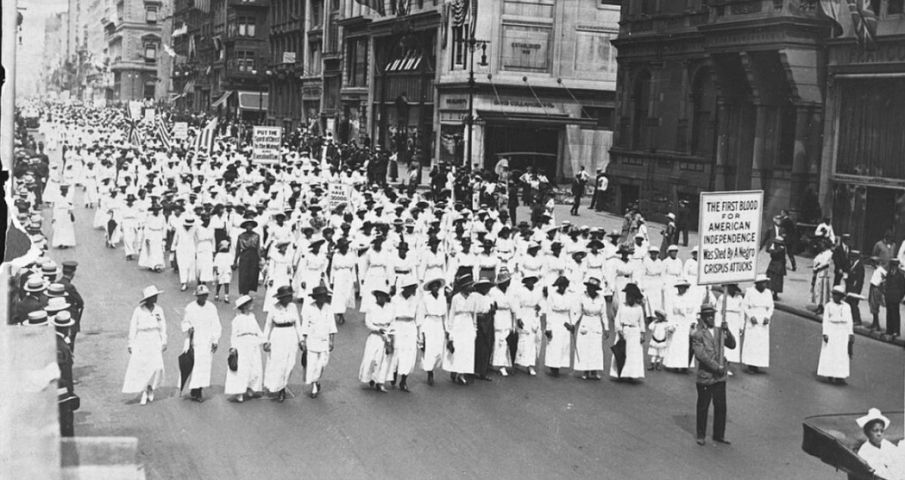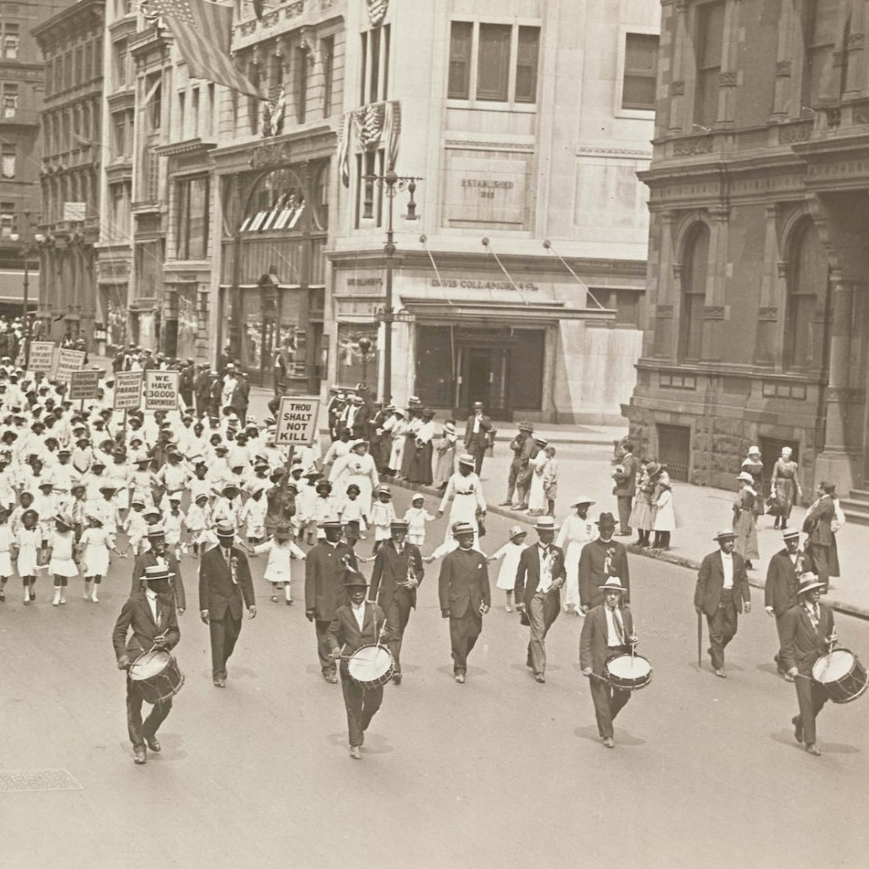Silent Protest Parade of 1917 in Madison Square
Jul 22, 2020

Content Warning: This article mentions racial violence.
In honor of its upcoming 103rd anniversary, the Flatiron Partnership looks back at the historic significance of the groundbreaking Fifth Avenue demonstration initiated by the National Association for the Advancement of Colored People (NAACP) on 59th Street, and the procession’s hushed finish on 23rd Street in the Flatiron District. The “Silent Protest Parade” on July 28, 1917 was one of the first U.S. civil rights public marches led by African-Americans.
“On the afternoon of Saturday, July 28, 1917, nearly 10,000 African-Americans marched down Fifth Avenue, in silence, to protest racial violence and white supremacy in the United States,” stated Chad Williams in an op-ed piece published in the Miami Herald. “New York City, and the nation, had never before witnessed such a remarkable scene.”
Just a few weeks prior to the march, noted the Herald, “Simmering labor tensions between white and Black workers exploded on the evening of July 2, 1917” in East St. Louis, Illinois. For a full 24-hour period, white mobs committed hundreds of egregious acts of racially motivated violence against Black people, with a death toll that was officially 39, but may have run as high as 100 or more according to Smithsonian Magazine.
The NAACP quickly responded to the massacre. According to the organization, they “soon issued a call for a Silent Protest Parade.” The NAACP, established in 1909, is self-described as the “nation’s foremost, largest, and most widely recognized civil rights organization.” NAACP leaders James Weldon Johnson and W.E.B. DuBois soon formed a Silent Protest Parade Committee that also included other influential members of the African-American community.

(Photo Credit: Underwood and Underwood courtesy of James Weldon Johnson Memorial Collection of African American Arts
and Letters, Yale Collection of American Literature, Beinecke Rare Book and Manuscript Library)
“We march because by the Grace of God and the force of truth, the dangerous, hampering walls of prejudice and inhuman injustices must fall,” noted the parade planners about their scheduled peaceful protest. “We march because we deem it a crime to be silent in the face of such barbaric acts. We march because we want our children to live in a better land and enjoy fairer conditions than have fallen to our lot. Be in line on Saturday and show that you have not become callous to the sorrows of your race.”
Circulars defining the parade’s mission were distributed to the quiet onlookers who appeared along the parade’s route. For the parade’s participants, however, “it was not until they reached Twenty-third Street, where they dispersed, that they permitted themselves a few outbursts of cheers, these being occasioned by the waving of some of their more elaborately inscribed banners calling for justice and equal rights,” noted the Times on July 29, 1917. Police estimates, according to the newspaper, indicated that “although there were not more than 8,000 in the parade itself,” over 20,000 members of the Black community lined Fifth Avenue and “gave silent approval of the demonstration.” The Silent Protest Parade that ended on 23rd Street in the Flatiron District would also become the blueprint for future marches throughout America during the decades to come, including the Black Lives Matter Marches of today.
The Silent Protest March “marked the beginning of a new epoch in the long Black freedom struggle,” noted the Miami Herald. “While adhering to a certain politics of respectability, a strategy employed by African-Americans that focused on countering racist stereotypes through dignified appearance and behavior, the protest, within its context, constituted a radical claiming of the public sphere and a powerful affirmation of Black humanity.”
Photo Credit: The Miami Herald







